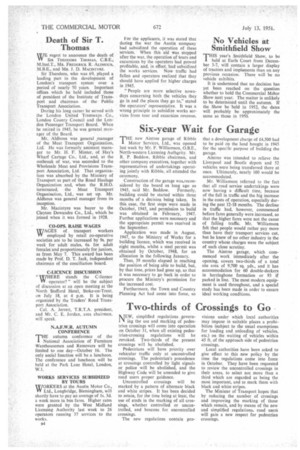Two-thirds of Crossings to Go.
Page 38

If you've noticed an error in this article please click here to report it so we can fix it.
NEw'simplified regulations . governing the use and marking of pedestrian crossings will come into operation on October 31, when all existing pedestrian-crossing regulations will be revoked. Two-thirds of the present crossings will be abolished.
Pedestrians will have priority over vehicular traffic only at uncontrolled crossings. The pedestrian's precedence at crossings controlled by light signals or police will be abolished, and the Highway Code will be amended to give road users proper guidance.
Uncontrolled crossings will be marked by a pattern of alternate black and white stripes. It has been decided to retain, for the time being at least, the use of studs in the marking of all crossings, whether controlled or uncontrolled, and beacons for uncontrolled crossings.
The new regulations contain pro visions under which local authorities may impose in suitable places a prohibition (subject to the usual exemptions for loading and unloading of vehicles, etc.) on the waiting of vehicles within 45 ft. of the approach side of pedestrian crossings.
Local authorities have been asked to give effect to this new policy by the time the regulations come into force in October. They have been requested to review the uncontrolled crossings in their areas, to select not more than a third which are regarded as being the most important, and to mark them with black and white stripes.
The Minister of Transport hopes that by reducing the number of crossings and improving the marking of those which remain, and by means of the new and simplified regulations, road users will gain a new respect for pedestrian crossings.




























































































